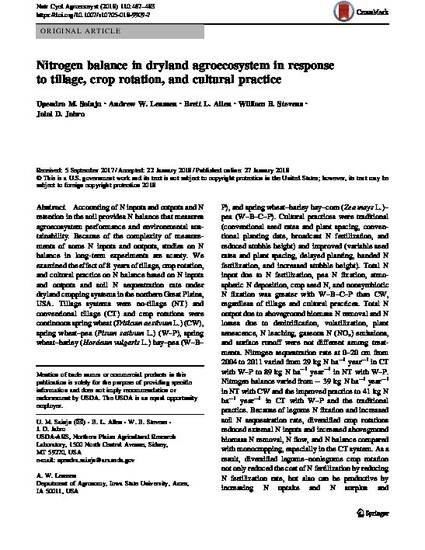
Accounting of N inputs and outputs and N retention in the soil provides N balance that measures agroecosystem performance and environmental sustainability. Because of the complexity of measurements of some N inputs and outputs, studies on N balance in long-term experiments are scanty. We examined the effect of 8 years of tillage, crop rotation, and cultural practice on N balance based on N inputs and outputs and soil N sequestration rate under dryland cropping systems in the northern Great Plains, USA. Tillage systems were no-tillage (NT) and conventional tillage (CT) and crop rotations were continuous spring wheat (Triticum aestivum L.) (CW), spring wheat–pea (Pisum sativum L.) (W–P), spring wheat–barley (Hordeum vulgaris L.) hay–pea (W–B–P), and spring wheat–barley hay–corn (Zea mays L.)–pea (W–B–C–P). Cultural practices were traditional (conventional seed rates and plant spacing, conventional planting date, broadcast N fertilization, and reduced stubble height) and improved (variable seed rates and plant spacing, delayed planting, banded N fertilization, and increased stubble height). Total N input due to N fertilization, pea N fixation, atmospheric N deposition, crop seed N, and nonsymbiotic N fixation was greater with W–B–C–P than CW, regardless of tillage and cultural practices. Total N output due to aboveground biomass N removal and N losses due to denitrification, volatilization, plant senescence, N leaching, gaseous N (NOx) emissions, and surface runoff were not different among treatments. Nitrogen sequestration rate at 0–20 cm from 2004 to 2011 varied from 29 kg N ha−1 year−1 in CT with W–P to 89 kg N ha−1 year−1 in NT with W–P. Nitrogen balance varied from − 39 kg N ha−1year−1 in NT with CW and the improved practice to 41 kg N ha−1 year−1 in CT with W–P and the traditional practice. Because of legume N fixation and increased soil N sequestration rate, diversified crop rotations reduced external N inputs and increased aboveground biomass N removal, N flow, and N balance compared with monocropping, especially in the CT system. As a result, diversified legume–nonlegume crop rotation not only reduced the cost of N fertilization by reducing N fertilization rate, but also can be productive by increasing N uptake and N surplus and environmentally sustainable by reducing N losses compared with nonlegume monocropping, regardless of cultural practices in dryland agroecosystems.
Available at: http://works.bepress.com/andrew_lenssen/144/

This article is published as Sainju, Upendra M., Andrew W. Lenssen, Brett L. Allen, William B. Stevens, and Jalal D. Jabro. "Nitrogen balance in dryland agroecosystem in response to tillage, crop rotation, and cultural practice." Nutrient Cycling in Agroecosystems 110, no. 3 (2018): 467-483. doi: 10.1007/s10705-018-9909-7